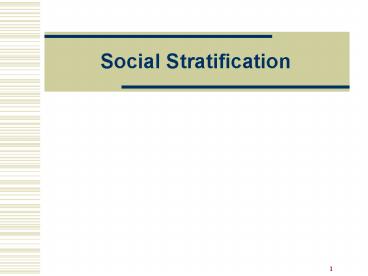Social Stratification - PowerPoint PPT Presentation
1 / 42
Title:
Social Stratification
Description:
capitalist class, or those who own the means of production ... class struggles would occur, as capitalists would continue to exploit workers for profit ... – PowerPoint PPT presentation
Number of Views:51
Avg rating:3.0/5.0
Title: Social Stratification
1
Social Stratification
2
Definitions
- Status
- Social differentiation
- Social stratification
3
Estate, Caste, and Class
- estate system of stratification,
- the elite have total control over societal
resources, including property and power
4
Estate, Caste, and Class
- caste system,
- status is ascribed
5
Estate, Caste, and Class
- class systems,
- class is somewhat based on achieved status
6
CLASS SYSTEM
- Social class (or class)
- the social structural position
7
CLASS SYSTEM
- Life chances
- identified by Max Weber
- the opportunities that people in a particular
class have in common
8
WHY IS THERE INEQUALITY?
- Karl Marx
- defined classes in terms of their relationship
to the means of production
9
Karl Marx
- capitalist class, or those who own the means of
production - working class, or those who labor for wages
10
Marxs View of Stratification
11
Karl Marx
- petty bourgeoisie, or small business owners and
managers, who identify with the capitalists - lumpenproletariat, who become the permanently
poor underclass.
12
Karl Marx
- class struggles would occur, as capitalists would
continue to exploit workers for profit
13
Max Weber Class, Status, and Party
- A person can rank high on one or two dimensions
and low on another - class as access to the material goods
14
Max Weber Class, Status, and Party
- status is the social judgement or recognition
given to a person or group. - party is the ability to impose one's will on
others,
15
Webers View of Stratification
16
Marx and Weber
- Marx argued that individuals act primarily on
economic interests - Weber - one's position in the stratification
system was the result of economic, social and
political forces
17
Functionalist Perspective on Inequality
- society as an interdependent system
- inequality motivates people to fill different
positions - poverty is necessary to maintaining social
stability
18
Conflict Perspective on Inequality
- society held together by conflict and coercion
- powerful groups maintain their advantage
- consequences of inequality are negative
19
CLASS STRUCTURE OF THE UNITED STATES
- Social class
- Social attainment
- Socio-economic status (SES)
- Income
- Occupational prestige
- Educational attainment
20
Layers of Social Class
- upper class, also known as elites
- nouveau riche have newly acquired wealth
21
Layers of Social Class
- upper-middle class - high incomes and high social
prestige - middle class clustered around the median income
- lower-middle class - skilled trades and
low-income bureaucratic workers
22
Layers of Social Class
- lower class - displaced and poor, - little formal
education - often unemployed or working for
minimum wage - People of color and women
- underclass - permanently unemployed
23
Class Conflict
- Classes compete with each other
- the elites exploit and dominate other classes.
24
Class Conflict
- Classes compete with each other
- the elites exploit and dominate other classes.
25
Class Conflict
- managerial class, -
- substantial control over other people, -
- but minimal control over the economic system
26
Class Conflict
- Conflict theorists believe
- elites blame the poor for their poverty
27
Distribution of Wealth and Income
- Wealth is the monetary value of everything one
owns - Income is the amount of money brought into a
household
28
Distribution of Wealth and Income
- The wealthiest 1 of Americans owns 37 of all
net worth - The wealthiest 10 controls 86 of the nations
wealth.
29
Distribution of Wealth and Income
- one-fifth of the nation's wealthiest people are
women - most wealthy women have inherited their wealth
30
Distribution of Wealth and Income
- one-third of Americans have no financial assets
at all
31
WHY IS WORLD INCOME DISTRIBUTED THIS WAY?
32
Sources of Stratification
- Race and gender are two of the primary influences
in the stratification system in the United States
33
Sources of Stratification
- majority of U.S. women work in low-prestige,
low-wage occupations and would likely be
considered working-class
34
Sources of Stratification
- The age group most likely to be poor are
children, - 20of U.S children live in poverty
35
SOCIAL MOBILITY
- A person's movement over time from one class to
another
36
SOCIAL MOBILITY
- Most people remain in the same class as their
parents - Mobility is strongly influenced by education
- Mobility can occur in two directions
37
Class Consciousness
- people in the United States do recognize class
divisions - False consciousness
38
POVERTY
- 35 million people
- 13.3 of the U.S. population, who are poor
39
POVERTY
- Some argue
- individual motivation and ability will allow
anyone to succeed in the U.S - This is called Blaming the Victim
40
POVERTY
- most of the able-bodied poor
- are employed
41
POVERTY
- Sociologists argue
- poverty is caused by complex economic and social
changes
42
Welfare
- a lifetime limit of five years for people to
receive welfare - recipients to find work within two years































